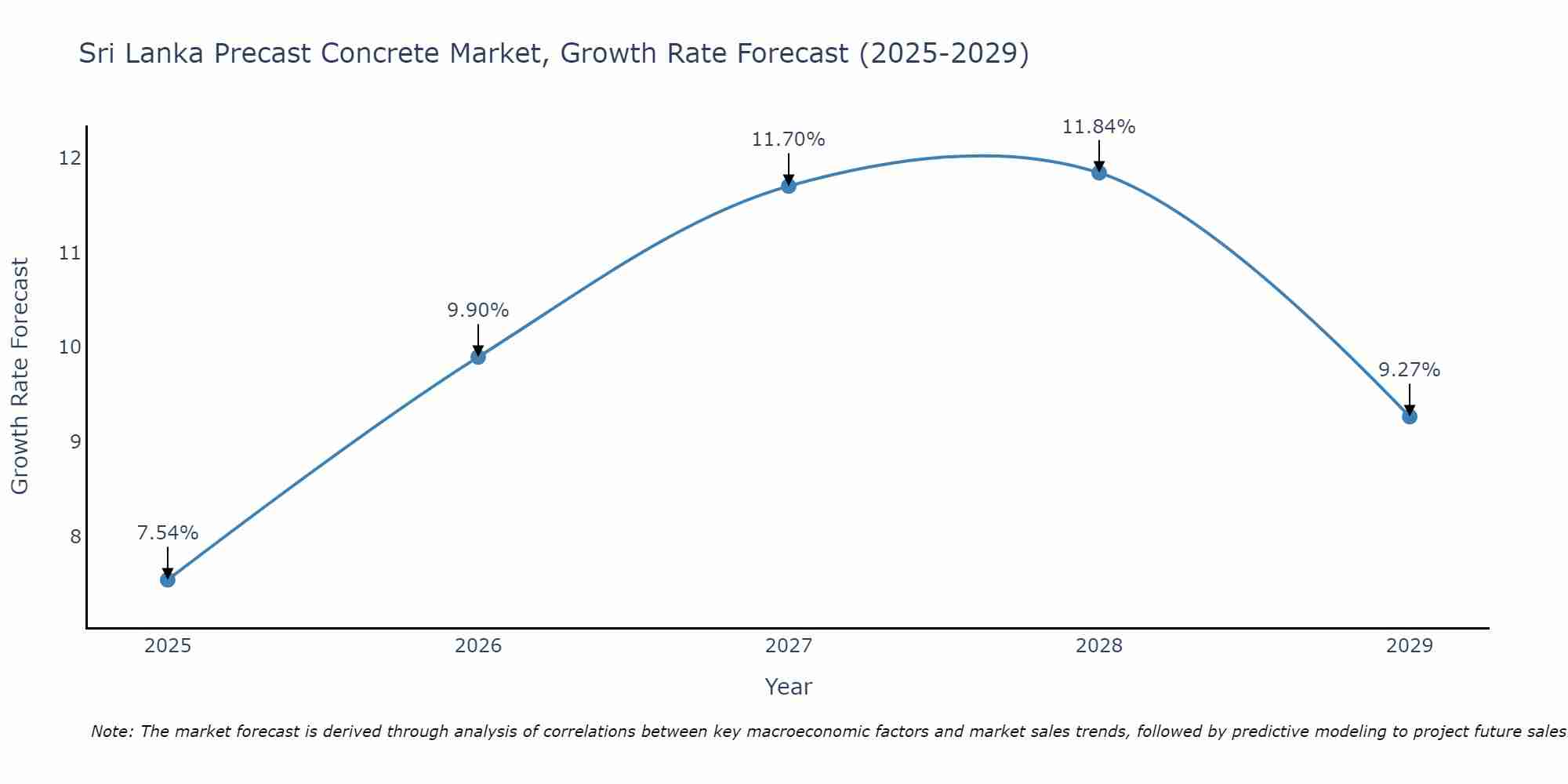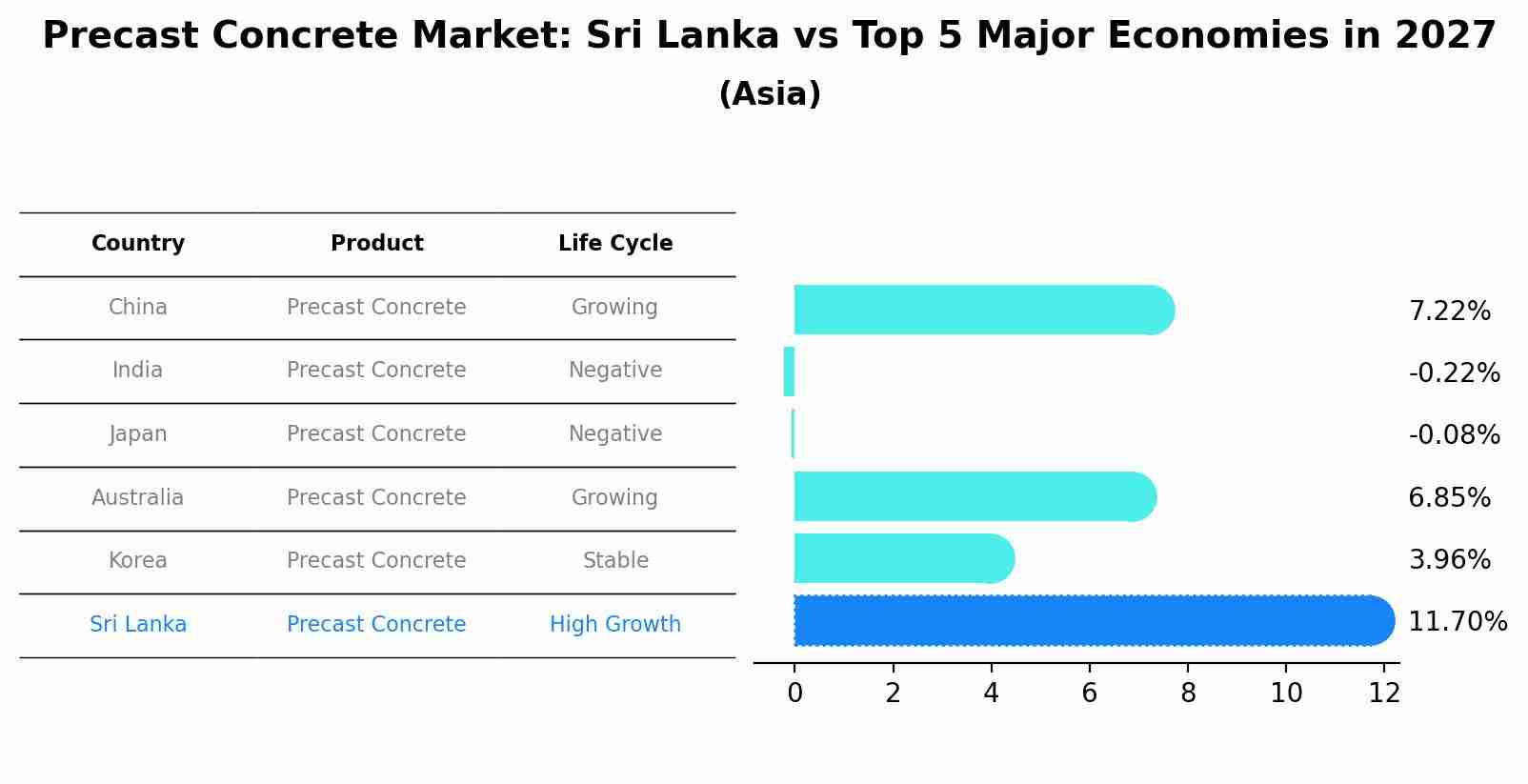Sri Lanka Precast Concrete Market (2025-2031) Outlook | Growth, Share, Trends, Size, Analysis, Industry, Forecast, Revenue, Value, Companies
| Product Code: ETC372871 | Publication Date: Aug 2022 | Updated Date: Jul 2025 | Product Type: Market Research Report | |
| Publisher: 6Wresearch | Author: Bhawna Singh | No. of Pages: 75 | No. of Figures: 35 | No. of Tables: 20 |
Sri Lanka Precast Concrete Market Size Growth Rate
The Sri Lanka Precast Concrete Market is projected to witness mixed growth rate patterns during 2025 to 2029. Growth accelerates to 11.84% in 2028, following an initial rate of 7.54%, before easing to 9.27% at the end of the period.

Precast Concrete Market: Sri Lanka vs Top 5 Major Economies in 2027 (Asia)
The Precast Concrete market in Sri Lanka is projected to grow at a high growth rate of 11.70% by 2027, within the Asia region led by China, along with other countries like India, Japan, Australia and South Korea, collectively shaping a dynamic and evolving market environment driven by innovation and increasing adoption of emerging technologies.

Sri Lanka Precast Concrete Market Synopsis
The Sri Lanka precast concrete market is experiencing steady growth due to the increasing construction activities in the country. Precast concrete products such as beams, columns, slabs, and walls are gaining popularity among contractors and developers for their durability, cost-effectiveness, and time-saving benefits. The market is driven by the government`s infrastructure development projects, urbanization, and the rising demand for affordable housing. Key players in the market are focusing on technological advancements, product innovations, and strategic collaborations to gain a competitive edge. However, challenges such as fluctuating raw material prices and lack of awareness about the benefits of precast concrete among customers may hinder the market growth. Overall, the Sri Lanka precast concrete market is poised for expansion in the coming years, offering opportunities for both local and international players.
Sri Lanka Precast Concrete Market Trends
The precast concrete market in Sri Lanka is experiencing growth due to the increasing demand for sustainable and cost-effective construction solutions. Key trends include the adoption of advanced technology to improve production efficiency, the use of innovative designs to meet aesthetic and functional requirements, and the emphasis on quality control and durability in precast concrete products. Additionally, the government`s infrastructure development projects are driving the demand for precast concrete components such as beams, columns, and slabs. Companies in the market are focusing on expanding their product offerings and enhancing their distribution networks to cater to the growing construction sector in Sri Lanka. Overall, the precast concrete market in Sri Lanka is poised for further growth as the construction industry continues to prioritize speed, efficiency, and sustainability in building projects.
Sri Lanka Precast Concrete Market Challenges
In the Sri Lanka precast concrete market, some of the main challenges faced include the lack of awareness and understanding of the benefits of precast construction methods among potential clients and stakeholders. This often leads to resistance to adopting precast solutions due to misconceptions about their quality, durability, and cost-effectiveness compared to traditional construction methods. Additionally, the limited availability of skilled labor and specialized equipment for precast concrete production can hinder the growth of the market. Infrastructure constraints, such as inadequate transportation facilities and high logistics costs, also pose challenges in efficiently delivering precast components to construction sites. Overcoming these challenges would require education and promotion efforts to increase acceptance and demand for precast concrete solutions, as well as investments in training programs and infrastructure improvements to support the industry`s expansion.
Sri Lanka Precast Concrete Market Investment Opportunities
The Sri Lanka precast concrete market presents various investment opportunities due to the country`s growing infrastructure development projects and increasing urbanization. Investors can consider opportunities in manufacturing precast concrete products such as beams, columns, and slabs to cater to the demand for sustainable and cost-effective construction solutions. Additionally, investing in innovative precast technologies and machinery can enhance production efficiency and quality, enabling companies to stay competitive in the market. Collaborating with local construction companies and government entities for large-scale projects can also provide a steady stream of business opportunities in the Sri Lankan precast concrete market. Overall, with the rising demand for precast concrete solutions in Sri Lanka`s construction sector, there is potential for investors to capitalize on this growing market.
Jordan Agar Market Government Policies
The Sri Lankan government has implemented various policies to promote the precast concrete market in the country. These policies include incentives for the use of precast concrete in construction projects, such as tax breaks and subsidies for precast concrete manufacturers. Additionally, the government has established quality standards and regulations to ensure the durability and safety of precast concrete products. Furthermore, there are initiatives to encourage the adoption of precast concrete technology in infrastructure development projects to improve efficiency and reduce construction time. Overall, the government`s policies aim to boost the growth of the precast concrete market in Sri Lanka and drive innovation in the construction industry.
Sri Lanka Precast Concrete Market Future Outlook
The future outlook for the Sri Lanka precast concrete market appears promising, with sustained growth expected in the coming years. Factors such as rapid urbanization, government infrastructure projects, and an increasing focus on sustainable construction practices are driving the demand for precast concrete products in the country. Additionally, the growing popularity of precast concrete due to its cost-effectiveness, time efficiency, and quality assurance benefits is expected to further boost market growth. As Sri Lanka continues to invest in infrastructure development, particularly in sectors such as transportation, residential, and commercial construction, the precast concrete market is likely to witness significant opportunities for expansion and innovation. Overall, the market is anticipated to experience steady growth driven by these favorable trends and increasing adoption of precast concrete solutions in the construction industry.
Key Highlights of the Report:
- Sri Lanka Precast Concrete Market Outlook
- Market Size of Sri Lanka Precast Concrete Market, 2024
- Forecast of Sri Lanka Precast Concrete Market, 2031
- Historical Data and Forecast of Sri Lanka Precast Concrete Revenues & Volume for the Period 2021 - 2031
- Sri Lanka Precast Concrete Market Trend Evolution
- Sri Lanka Precast Concrete Market Drivers and Challenges
- Sri Lanka Precast Concrete Price Trends
- Sri Lanka Precast Concrete Porter's Five Forces
- Sri Lanka Precast Concrete Industry Life Cycle
- Historical Data and Forecast of Sri Lanka Precast Concrete Market Revenues & Volume By Product for the Period 2021 - 2031
- Historical Data and Forecast of Sri Lanka Precast Concrete Market Revenues & Volume By Structural Building Components for the Period 2021 - 2031
- Historical Data and Forecast of Sri Lanka Precast Concrete Market Revenues & Volume By Architectural Building Components for the Period 2021 - 2031
- Historical Data and Forecast of Sri Lanka Precast Concrete Market Revenues & Volume By Transportation Products for the Period 2021 - 2031
- Historical Data and Forecast of Sri Lanka Precast Concrete Market Revenues & Volume By Water & Waste Handling Products for the Period 2021 - 2031
- Historical Data and Forecast of Sri Lanka Precast Concrete Market Revenues & Volume By Others for the Period 2021 - 2031
- Historical Data and Forecast of Sri Lanka Precast Concrete Market Revenues & Volume By End-use for the Period 2021 - 2031
- Historical Data and Forecast of Sri Lanka Precast Concrete Market Revenues & Volume By Residential for the Period 2021 - 2031
- Historical Data and Forecast of Sri Lanka Precast Concrete Market Revenues & Volume By Non-residential for the Period 2021 - 2031
- Historical Data and Forecast of Sri Lanka Precast Concrete Market Revenues & Volume By Infrastructure for the Period 2021 - 2031
- Sri Lanka Precast Concrete Import Export Trade Statistics
- Market Opportunity Assessment By Product
- Market Opportunity Assessment By End-use
- Sri Lanka Precast Concrete Top Companies Market Share
- Sri Lanka Precast Concrete Competitive Benchmarking By Technical and Operational Parameters
- Sri Lanka Precast Concrete Company Profiles
- Sri Lanka Precast Concrete Key Strategic Recommendations
Frequently Asked Questions About the Market Study (FAQs):
- Single User License$ 1,995
- Department License$ 2,400
- Site License$ 3,120
- Global License$ 3,795
Search
Thought Leadership and Analyst Meet
Our Clients
Related Reports
- Canada Oil and Gas Market (2026-2032) | Share, Segmentation, Value, Industry, Trends, Forecast, Analysis, Size & Revenue, Growth, Competitive Landscape, Outlook, Companies
- Germany Breakfast Food Market (2026-2032) | Industry, Share, Growth, Size, Companies, Value, Analysis, Revenue, Trends, Forecast & Outlook
- Australia Briquette Market (2025-2031) | Growth, Size, Revenue, Forecast, Analysis, Trends, Value, Share, Industry & Companies
- Vietnam System Integrator Market (2025-2031) | Size, Companies, Analysis, Industry, Value, Forecast, Growth, Trends, Revenue & Share
- ASEAN and Thailand Brain Health Supplements Market (2025-2031) | Strategy, Consumer Insights, Analysis, Investment Trends, Opportunities, Growth, Size, Share, Industry, Revenue, Segments, Value, Segmentation, Supply, Forecast, Restraints, Outlook, Competition, Drivers, Trends, Demand, Pricing Analysis, Competitive, Strategic Insights, Companies, Challenges
- ASEAN Bearings Market (2025-2031) | Strategy, Consumer Insights, Analysis, Investment Trends, Opportunities, Growth, Size, Share, Industry, Revenue, Segments, Value, Segmentation, Supply, Forecast, Restraints, Outlook, Competition, Drivers, Trends, Demand, Pricing Analysis, Competitive, Strategic Insights, Companies, Challenges
- Europe Flooring Market (2025-2031) | Outlook, Share, Industry, Trends, Forecast, Companies, Revenue, Size, Analysis, Growth & Value
- Saudi Arabia Manlift Market (2025-2031) | Outlook, Size, Growth, Trends, Companies, Industry, Revenue, Value, Share, Forecast & Analysis
- Uganda Excavator, Crane, and Wheel Loaders Market (2025-2031) | Strategy, Consumer Insights, Analysis, Investment Trends, Opportunities, Growth, Size, Share, Industry, Revenue, Segments, Value, Segmentation, Supply, Forecast, Restraints, Outlook, Competition, Drivers, Trends, Demand, Pricing Analysis, Competitive, Strategic Insights, Companies, Challenges
- Rwanda Excavator, Crane, and Wheel Loaders Market (2025-2031) | Strategy, Consumer Insights, Analysis, Investment Trends, Opportunities, Growth, Size, Share, Industry, Revenue, Segments, Value, Segmentation, Supply, Forecast, Restraints, Outlook, Competition, Drivers, Trends, Demand, Pricing Analysis, Competitive, Strategic Insights, Companies, Challenges
Industry Events and Analyst Meet
Whitepaper
- Middle East & Africa Commercial Security Market Click here to view more.
- Middle East & Africa Fire Safety Systems & Equipment Market Click here to view more.
- GCC Drone Market Click here to view more.
- Middle East Lighting Fixture Market Click here to view more.
- GCC Physical & Perimeter Security Market Click here to view more.
6WResearch In News
- Doha a strategic location for EV manufacturing hub: IPA Qatar
- Demand for luxury TVs surging in the GCC, says Samsung
- Empowering Growth: The Thriving Journey of Bangladesh’s Cable Industry
- Demand for luxury TVs surging in the GCC, says Samsung
- Video call with a traditional healer? Once unthinkable, it’s now common in South Africa
- Intelligent Buildings To Smooth GCC’s Path To Net Zero


















